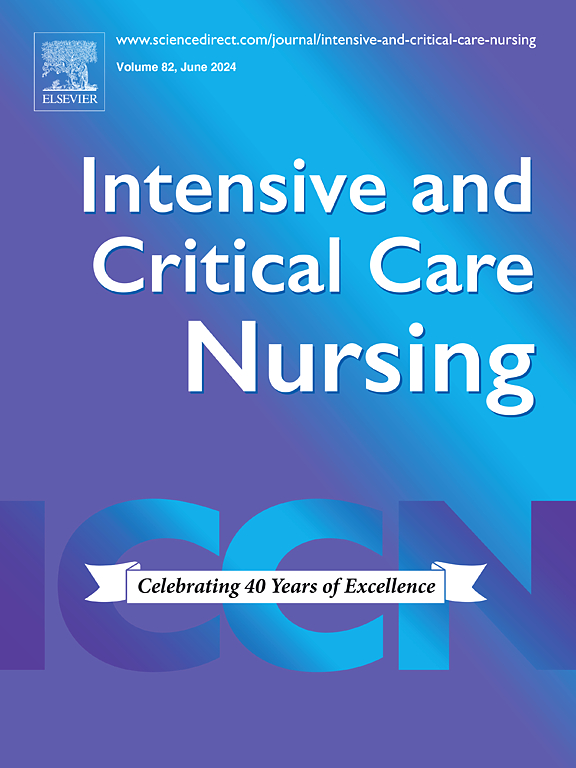Impact of the environment on health status of intensive care unit patients: Functional data analysis using wearable monitoring systems
IF 4.7
2区 医学
Q1 NURSING
引用次数: 0
Abstract
Objectives
Environmental factors in critical care units (ICUs) can significantly impact patient health. Traditional analysis methods often struggle with the continuous temporal data from wearable monitoring devices. This study explores the novel application of functional data analysis (FDA), a methodology well suited for continuous signals, to assess how environmental exposures influence ICU patient outcomes over time. Specifically, it examines the most impactful environmental variables. It evaluates FDA’s effectiveness in analysing continuous data from wearable monitoring devices, in contrast to traditional methods that overlook temporal patterns by using average or isolated measurements.
Methods
A prospective cohort study was conducted in a tertiary-level reference ICU in southern Spain, where wearable sensors were used to collect physiological and environmental data from 77 adult patients continuously. Functional data analysis (FDA) techniques were employed to explore temporal patterns in the collected signals.
Results
Noise intensity (decibels) was the most significant environmental variable, correlating with Richmond Agitation-Sedation Scale (RASS) scores and heart rate (HR). Functional additive models significantly improved model performance, achieving R2 values up to 0.78 for RASS prediction in trauma patients. Effects varied across patient diagnosis subgroups.
Conclusions
FDA techniques, particularly functional additive models, better model complex relationships between environmental and physiological variables in the ICU. Environmental impacts differ across patient types, suggesting the need for specialised environmental interventions based on patient condition.
Implications for Clinical Practice
This study underscores the need for environmental monitoring in ICUs and highlights the potential of wearable sensors and advanced statistical analysis to optimise patient care and improve outcomes by tailoring environmental interventions to specific patient needs.
环境对重症监护病房患者健康状况的影响:使用可穿戴监测系统的功能数据分析
目的重症监护病房(icu)环境因素对患者健康有显著影响。传统的分析方法往往难以处理来自可穿戴监测设备的连续时间数据。本研究探索了功能数据分析(FDA)的新应用,这是一种非常适合连续信号的方法,用于评估环境暴露如何随时间影响ICU患者的预后。具体来说,它考察了最具影响力的环境变量。它评估了FDA在分析可穿戴监测设备连续数据方面的有效性,而传统方法通过使用平均或孤立的测量来忽略时间模式。方法在西班牙南部的三级参考ICU进行前瞻性队列研究,使用可穿戴传感器连续收集77名成年患者的生理和环境数据。功能数据分析(FDA)技术用于探索所收集信号的时间模式。结果噪声强度(分贝)是最显著的环境变量,与Richmond躁动镇静量表(RASS)评分和心率(HR)相关。功能相加模型显著提高了模型性能,创伤患者RASS预测的R2值高达0.78。不同患者诊断亚组的效果不同。结论fda技术,尤其是功能相加模型,能更好地模拟ICU环境和生理变量之间的复杂关系。环境影响因患者类型而异,这表明需要根据患者状况进行专门的环境干预。本研究强调了icu环境监测的必要性,并强调了可穿戴传感器和先进统计分析的潜力,通过针对特定患者需求定制环境干预措施来优化患者护理和改善结果。
本文章由计算机程序翻译,如有差异,请以英文原文为准。
求助全文
约1分钟内获得全文
求助全文
来源期刊

Intensive and Critical Care Nursing
NURSING-
CiteScore
6.30
自引率
15.10%
发文量
144
审稿时长
57 days
期刊介绍:
The aims of Intensive and Critical Care Nursing are to promote excellence of care of critically ill patients by specialist nurses and their professional colleagues; to provide an international and interdisciplinary forum for the publication, dissemination and exchange of research findings, experience and ideas; to develop and enhance the knowledge, skills, attitudes and creative thinking essential to good critical care nursing practice. The journal publishes reviews, updates and feature articles in addition to original papers and significant preliminary communications. Articles may deal with any part of practice including relevant clinical, research, educational, psychological and technological aspects.
 求助内容:
求助内容: 应助结果提醒方式:
应助结果提醒方式:


